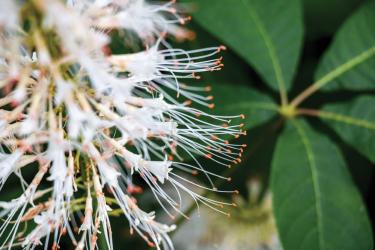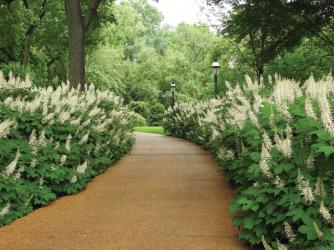On an autumn day, the Missouri Botanical Garden is brimming with color from a diverse array of fall foliage. Among the most striking hues is the golden yellow of the bottlebrush buckeye that lines the sidewalk leading south from the Climatron. This eye-catching plant is also of conservation in North America.
Bottlebrush buckeye, Aesculus parviflora, is endemic to Alabama, southwest Georgia and one county in South Carolina. The species is considered G3-Vunerable in NatureServe, with an estimate of less than 100 occurrences.
Aesculus parviflora is found in isolated populations on bluffs and ravines, where its large seeds are dispersed by water. Populations occur along a number of distinct waterways, all draining from the southern Appalachian highlands, and likely display genetic variation among them. Major threats to this species include narrow range and specific habitat, land development, alterations to hydrological systems by damming and coal mining, habitat alteration and invasive species.
Despite the threats and horticultural use, this species has been little studied. Surveying the native occurrences and genetics of this species, and its collection is important for understanding the ecology of this species and to assure it is preserved, as well as beneficial to horticulture. In a home garden, bottlebrush buckeye does best in part to full shade. It can grow 8 to 12 feet high with a spread of 8 to 12 feet. It blooms in June and July, producing white tubular flowers with yellow anthers that attract butterflies.









